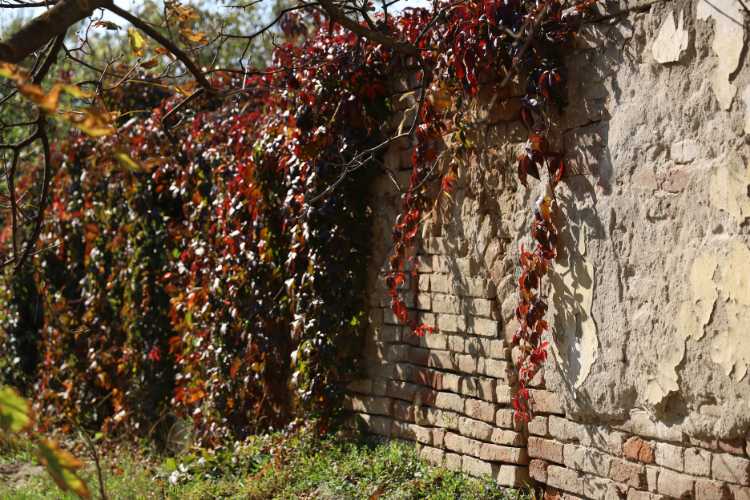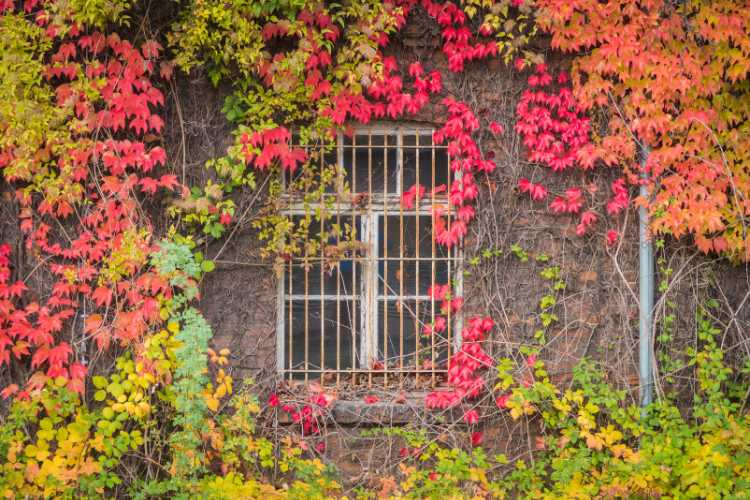10 Ways to Use Climbing Plants in Your Garden
9th Oct 2023
Our gardens are ever-changing and that is why we love our plants. The variety of colours, of species, of height, and coverage. You could say a garden is a living canvas and of all the different kinds of plants to add depth and character to that canvas are climbers.
Popular climbing plants such as honeysuckle, clematis, and climbing roses are not only aesthetically pleasing, but they also bring functional benefits to the garden. Which has to be good news but how can you use climbing plants in your garden?
Top 10 ways to use garden plants in your garden
1. Fences & Trellises
Ah, fences. We all need them but how do we stop them looking like… a fence? That’s easy. We cover them up. And there is a certain old-world charm about a garden fence or trellis laden with blossoms and foliage. They just look so elegant when covered with blooming flowers.
Not only do climbing plants turn these garden staples into features, but they also offer a dynamic seasonal display. British-native climbers, such as the delicate jasmine or the vigorous wisteria, can transform even the simplest and most boring fence into a wonderful living showpiece, changing with each season.
2. Pergolas & Gazebos
It may not happen too often but when the British summer is at its height and long lazy days are the norm there is nothing better than sitting in the garden with a glass of something nice on a warm evening.
Imagine sitting under a pergola in mid-summer, surrounded by cascading flowers, their scent wafting on a warm breeze. An idyllic scene but very achievable when you use climbing plants to accentuate your arbours, gazebos, or pergola.
Climbers can turn structures like these into intimate, shaded retreats. A twining honeysuckle or a climbing rose, with its wonderful fragrance, can be the finishing touch your garden seating area needs.
3. Garden Arches
An arch adds height and interest to the garden but an archway adorned with colourful climbing plants is like a portal to another world. Walking beneath, you're momentarily wrapped in a fragrant embrace. The romance of a rose intertwined with honeysuckle not only looks spectacular but also offers a multi-sensory experience. An arch festooned with plants is an amazing and effective way to lead from one area of the garden to another.
4. Soften those Walls
One of the neverending challenges for a gardener is how to disguise or at least soften the appearance of brick walls. Whether that is the wall of the house, the garage, or a boundary.

Of course brick and stone can have a beauty all of their own but mostly they simply appear stark and bare. But the clever use of climbing plants can provide a softening effect, making buildings and walls seem an (almost) organic part of the garden landscape.
Ivy, with its classic appeal, or the colourful clematis, which thrives in the varied British weather, can make any wall come alive with greenery and will spread very quickly. Though you do have to make sure it doesn’t completely overtake the area.
5. Natural Privacy Screens
Being overlooked in our gardens and having another garden behind the fence is something which urban gardeners have to contend with. Naturally enough then in our cramped modern world, a touch of privacy is a cherished commodity.
But instead of opting for wooden panels or bamboo screening, consider a living wall of climbers. Fast-growing varieties, like the golden hop or the passionflower, can provide a dense screen, giving your garden an intimate, secluded feel while still feeling open and airy.
6. Ground Cover
Ok, hear me out here. I’ve not gone completely mad. Climbing plants don’t have to be just for growing up a wall! Varieties like the low-growing clematis can be trained to sprawl horizontally. It’ll not only suppress weeds but will deliver beautiful and colourful ground-based blooms. These provide a lush carpet, especially useful in spaces where grass struggles or for adding interest in the lower reaches of the garden.
7. Pot & Container Gardening
When thinking about climbing plants it would be safe to assume that you need a big garden to accommodate them. Well, maybe not. For those with smaller spaces such as patios or even balconies, despair not you can still enjoy climbers!
With a sturdy container and a mini trellis, climbers can flourish in even the smallest spaces. This method is also perfect for those with challenging soils who find it difficult to grow anything in the ground. Choices like the evergreen jasmine or the balcony-friendly clematis are ideal for making a bit of container magic.
8. Mixed Planting
Mixing plants whether in borders, pots, or formal gardens adds interest and colour to any planting scheme. But there is a bit of an art to pairing climbers with other plants. Imagine a climbing rose weaving its way through a wisteria, creating a layered bloom effect. Or a vibrant clematis darting through a hedge. These kinds of combinations can provide extended flowering periods, ensuring your garden remains vibrant, colourful, and interesting throughout the year.
9. Hide Garden Structures
Unfortunately many gardens have their less-than-picturesque elements, be it a shed, utility pole, or compost bin. My particular pain was a revolving clothesline which had been cemented into place and which my wife flatly refused to let me get rid of.
But climbers, with their fast growth and spread, can be trained around these, making them disappear under a blanket of foliage and blooms. Choices like the Virginia creeper, with its autumnal hues, can turn an eyesore into an attraction. Unfortunately I have to admit it doesn’t really work with a clothesline.
10. Habitat for Wildlife
Our gardens are wonderful sanctuaries for us, but they can also be havens for wildlife. Climbers like honeysuckle not only look and smell wonderful but they also attract pollinators, providing nectar for bees and a place of interest for birds. By choosing native climbers, we can support our local ecosystems. And, as the saying goes, every little helps.
So, there you go. Just ten ways you can use climbing plants in your garden. There’s got to be at least one there which appeals. Which is all well and good of course but which climbers can or should you use? Glad you asked. Here’s a selection for you.
10 of the Most Popular Climbing Plants
Climbing rose: Probably the most popular climber and highly regarded for its aromatic blooms. Climbing roses come in many different colours and varieties but all will add classic elegance to any garden.
Clematis: A traditional favourite with British gardeners. With its huge and diverse range of flower shapes and colours, clematis is a must-have. It is of course known for its vigorous growth and long bloom periods.
Climbing hydrangea: Who doesn’t love a hydrangea? Recognised for its lace-cap flowers, this climber boasts beautiful heart-shaped leaves and offers excellent wall coverage.
Jasmine: Not just a love interest for Aladdin but also adored for its intoxicating fragrance, jasmine produces delicate white or yellow flowers, and looks simply amazing.
Virginia creeper: A famous name and with its fiery autumn colours, this climber's five-pointed leaves create a stunning seasonal spectacle.
Russian vine: If you’re looking for fast cover the Russian vine is the climber for you. Also known for very good reasons as 'mile-a-minute', it’s a fast grower which produces cascading sprays of tiny white flowers.
Hedera ivy: Usually seen rambling over old houses and a staple for the vicarage. A classic evergreen climber, ivy is versatile and fast growing, offering dense coverage and beautiful lobed leaves.
Wisteria: A beautiful and traditional budget with its pendulous racemes of fragrant flowers, wisteria is a statement maker, especially in spring. It will look fantastic in any setting or garden.
Chocolate vine akebia: Named for its cocoa-scented blooms, this semi-evergreen climber also produces intriguing purple fruits. One of the more unusual climbers, this plant will make your garden stand out from the crowd.
Passionflower: Not one often found in UK gardens. Exotic in appearance, its intricate flowers are a mesmerising sight, making it a wonderful addition to your planting scheme.

The Unending Charm of Climbing Plants in the Garden
I think you’ve probably worked out by now that I’m a big fan of using climbing plants in the garden. They really can make a huge difference to a space - especially when they are meandering around an archway or across a wall. Colour, texture, fragrance - you get them all.
Best of all, it doesn’t matter how much space you have. Whether you’re an urban gardener with a balcony or are lucky enough to have a large garden, everyone can enjoy climbers. As we’ve mentioned, climbing plants can turn any nook or corner into a living oasis of calm.
Climbing plants can become a mirror of the changing seasons, your planting scheme evolving with time and providing an ever-shifting and colourful landscape in your garden. What better way to connect with nature?
Feeling inspired? Browse our extensive collection of climbers and let your garden imagination run wild. Whether it's a trellis transformed by roses or a balcony graced by clematis, we’ve got the plants you need. Check out the full range here and don’t forget to sign up for our Discount Club and newsletter to enjoy amazing savings on all your favourite plants, shrubs, and ornamental trees.


